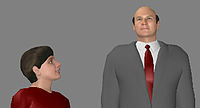 Original storyboard frame
For this frame, you used a 40mm lens which is a neutral lens. It is not telephoto and it is not wide angle. Therefore, the lens does not have any distortion. This makes the scene uninteresting.
Also, the story is about the boy but you put the camera at the height of the man.
|
|
Cold and separate  Wide angle
A wide angle lens makes people seem distant from each other; not warm or friendly. At the beginning of the scene, the man and the boy are distant from each other emotionally. To show this, I use a wide angle lens.
Here I lowered the camera to just below the boy's head and I tilted the camera up. Now the man seems very tall and very distant.
|
|
Warm, friendly, and together  Telephoto
A telephoto lens makes people look warm and close together. At the end of the movie, the man and the boy are close together emotionally. So for the shots at the end of the scene, you can use a telephoto lens.
In this shot, I lowered the camera and I tilted the camera up. Therefore, to get this shot, I must lower the camera almost on the ground to get this shot. The lens of the camera is only a half a meter off the ground.
|





















